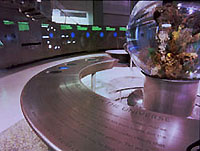Website
http://www.amnh.org/rose/Address & Phone
Entrance on 81st Street just off of Central Park WestNew York, NY
P: (212) 769-5100
At the American Museum of Natural History

Ecosphere in the Hall of the Universe
© AMNH/D. Finnin Visiting Information Bringing the Universe Down to Earth
The Lewis B. and Dorothy Cullman Hall of the Universe, located on the Lower Level, is a sleek silver circular space directly below the Hayden Sphere. The floor is vibrant with galaxies, a nebula, and a star inlaid in colorful glass mosaic; the hall comes alive with familiar artifacts, a futuristic fishbowl and numerous hands-on exhibits.
Divided into zones for Planets, Stars, Galaxies and the Universe, the Hall explores the large questions that astrophysics aims to answer. Interactive exhibits illustrate how the universe evolved into the galaxies, stars, and planets that now exist; how the atoms from which we are made were created; and where the matter necessary for life came from. Finding out your weight on the moon, a popular feature of the old planetarium, has expanded to include scales for your weight on Saturn, Jupiter, a neutron star and the sun.
In the Planets Zone, you will be greeted by the Williamette Meteorite, a 15-ton shard of cosmic debris, and a beautiful Ecosphere, a sealed self-sustaining habitat. Behind the meteorite, a kinetic sculpture shows how craters form, framed by information about the impacts that Earth has endured so far and the potential effects of future collisions on our planet.
The Star Zone illustrates how the building blocks of life are born from stars, what Carl Sagan meant when he said "we are starstuff". When these often romanticized bundles of energy exploded as supernovas, the elements that compose our bodies were first created. The fantastic power and beauty of stars is further shows with a rear projection video, a computer interactive and a swirling disk of heated fluid.
The Galaxy Zone explores the dynamic interplay of these enormous clouds of stars and gas. A three dimensional floating image prompts galaxies to collide before your eyes, framed by facts about their formation, evolution and diversity.
The Universe Zone takes you to the furthest reaches of the known universe. In the Black Hole Theater, you can experience the crush of gravity and the warping of time and space thanks to excellent computerized visualizations. This zone is also home to a Hoberman Sphere, a phosphorescent sculpture which accurately demonstrates the expansion of the universe.
In order to bring the public closer to scientists and their work, the Center has created the "AstroBulletin". This electronic science bulletin will display the latest news and images of cosmic events and will feature computer kiosks where curious visitors can pose questions or read news from NASA.
- Reviews of At the American Museum of Natural History
